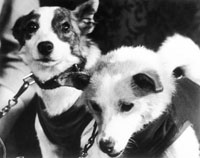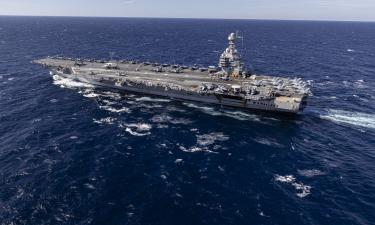30 Soviet mongrel dogs paved the way into space for entire mankind
On the 22nd July it will be 55 years since the first astronaut went into space… Wait! What about Yuri Gagarin? What about the 12th April 1961 ? There is no mistake here. In July 1951, the first launch of a passenger spacecraft took place with two crew members on board. One was called Gypsy, the other, Dezik. Doctor Alexandr Seryapin was amongst those who prepared the four-legged astronauts for take-off.

A coward named Brave.
Already in 1949, experiments on animals began. In these, our group from the institute of aviation medicine took part. The task was to study the possibility of surviving a flight at a height of 110 to 470 kilometres.
We used mongrel dogs as they are tough and not capricious. Altogether we took 32 dogs. We trained them on a vibrostand, a centrifuge, a pressure chamber… For space travel we created a special hermetic cabin that was held in the nose section of the rocket.
The flights took place at the Kapustin Yar polygon. The first launch was successful. Gypsy and Dezik reached 110 kilometres, then the cabin that contained them free-fell to a height of seven kilometers. At this point a parachute opened and both astronauts landed safely.
Out of everyone, Korolev was most pleased by the success. He stroked the animals, treated them to sausage, put them in his car and drove them home to the enclosure where they lived.
Unfortunately, the second launch proved unsuccessful: the parachute did not open and the cabin with the two dogs fell sharply to the ground. For the duration of the experiments right up to the Spring of 1961, we launched 29 rockets with animals inside. 10 dogs died during the experiments, including my favourite, Lisa.
Somehow, it happened that for the 1951 launch, only the main crew was at the polygon. One of the two puppies, known as Brave, had already been in space. On the evening before his flight, the lab assistant took the mongrel for a walk. As soon as he unfastened the leash, Brave threw himself forward. It seems he sensed that corporal punishment awaited him again. He bolted out towards the steppe and however much they called him, he did not return.
What could they do? They wanted to report to Korolev, but the lab assistant who had let Brave out suddenly suggested that they send one of the local dogs that continuously wandered around the military canteen on the flight. I chose a mongrel of the right size, we cleaned her, cut her fur in places where it was necessary to implant sensors, dressed her in the spacesuit… The launch went well and the animals returned to earth alive and well.
Having walked up to the fallen cabin, Korolev immediately noticed the crew substitution. He was shocked: “Where did you get that dog? What is her name?” We had to reply that her name was ZIB (Reserve for Disappeared Bobik) and explain everything that had happened the evening before. At this point the lab assistant came up and informed everyone that sly Brave had returned from his absence and was sleeping in his place.
Only girls in the squad
From 1952 onwards we started to perfect flights with animals in spacesuits. The spacesuits were made from perforated material in the shape of a sack with two closed sleeves for the front paws. Attached to this was a removable helmet made from transparent plexiglass. In addition, we created a catapult trolley, on which a tray was placed containing the dog and also the equipment. This construction shot out from the falling cabin at a great height and dropped to the ground with a parachute.
At the beginning of 1956, Korolev set a new task: to prepare a 30 day flight for two dogs. There were many difficulties: creating a new hermetic cabin, setting up a system of air regeneration ,inventing afood mixture and an automatic device for regularly feeding the four-legged astronauts.
For the long flights we only chose females. It turned out to be easier for them to use the space toilet. From behind, a pipe leading to the flying suit was installed, and through it, all waste from bodily functions was automatically sucked into a sack. For feeding, a special conveyor belt was created. Once a day, from under the tray in which the dog was lying, a new box emerged on a moving belt, full of a special, doughy mixture – this served as both food and drink.
Go Laika!
On one occasion, Korolev and Keldysh came to us and asked: “How long do you need to prepare a dog for a seven day flight into space?”
“One and a half months.”
“Great, you have three weeks.”
This was how the epic launch of the famous Laika began. She became a hero quite by chance. We prepared 5 dogs for this flight. We took all of them to Baikonur before take-off and already showed them to the management there. One of the generals liked the look of Laika, the others agreed.
We knew that the dog would not return to Earth. The spaceship did not contain descent apparatus. We estimated that Laika would last one week alive on board. Food and oxygen supplies were calculated to last for exactly this long. In order that the dog should not suffer after the air ran out, the constructers invented a needle, which would becontrolled by the team on Earth to give the animal a fatal injection. But…
Firstly, due to a technical problem, the rocket with Laika already inside the cabin stayed on the launch pad for almost three days. This took place in November and it was cold outside. To stop the dog from getting cold, Korolev gave orders to extend a hose and warm up the cabin from the outside with hot air…
On Earth, Laika almost became numb with cold, however, in space, extreme heat awaited her. On entering orbit, the satellite began to heat up from the rays of the sun. The temperature in the stuffy cabin had already reached 40 degrees by the fifth orbit and the dog’s body could not hold out.
Five Easts away from Gagarin
At the beginning of 1960, a rocket and spacecraft named East were prepared for a flight with a human crew. But Korolev decided to check the security of every joint and on-board system in pilot-less conditions. Five spaceships were set aside for this test. The first one took off with a load mimicking the weight of a person inside.
East orbited the Earth for four days but did not come back. Due to a fault in the orientation system, it began to distance itself from our planet. On board the second spaceship, two dogs were sent together with the load, Belka and Strelka, as well as several dozen biological objects: mice, drosophila flies, peas, wheat grain and even specimens of human blood, skin and cancerous tumour cells. In 22 hours, the spaceship orbited earth 18 times before landing.
The next launch, however, ended unsuccessfully. On the 1st December 1960 , East took off with Pchelka and Mushka on board. These dogs circled the Earth seven times, but on returning, the module made an unforeseen trajectory as it fell and burnt up.
Two more versions of East took off on the 9th and 21st March 1961. Both of these worked through the exact programme to be used on the forthcoming piloted flight: they orbited once, then landed. A wooden mannequin sat on the catapult seat. Next to him sat a dog. Only after these tests did Korolev announce at a meeting of the State Commission: “The machinery is ready!”
Trud
Translated by Leila Wilmers
Discuss this article on Pravda.ru English Forum
Subscribe to Pravda.Ru Telegram channel, Facebook, RSS!




